James A Shapiro Natural Genetic Engineering and Evolution Part Two
In part one we discussed how advances in science had rendered portions of Darwin’s Original 1859 theory antiquated and obsolete. In addition, a later revision of Darwin, neo-Darwinism updated with new knowledge of genetics, has also been rendered obsolete by new scientific understandings in molecular biology and cytogenetics.
Evolution: A View From the 21st Century
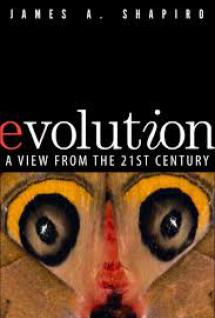 James A. Shapiro, author of
James A. Shapiro, author of
Evolution: A View from the 21st Century , and Professor of Microbiology, professor of genetics at the University of Chicago has written extensively about this topic. His blog at Huffington Post provides the public with non-technical explanations of these new advances in science.
In Part Two, we will rely on Dr Shapiro’s prose and wit to bring us up to speed on the new Non-Darwinian thinking about evolution.
Middle Ages and Suppression of Science
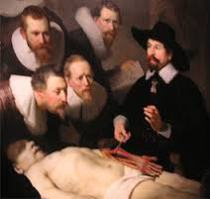 Firstly a little historical perspective on science. Through much of the Middle Ages, the prevailing culture prohibited the study of human anatomy, or any medical science for the alleviation of disease. These people were found guilty of witchcraft and burned at the stake. Needless to say, this provided a powerful disincentive to study human anatomy, medicine or even science for that matter. Things turned around in the 1600’s with the “Enlightenment” . The study of human anatomy could now be done in the open, and was celebrated with group portraits by leading artists. See left image: the Anatomy Lesson Nicolas Tulp 1632 by Rembrandt courtesy of Museum.
Firstly a little historical perspective on science. Through much of the Middle Ages, the prevailing culture prohibited the study of human anatomy, or any medical science for the alleviation of disease. These people were found guilty of witchcraft and burned at the stake. Needless to say, this provided a powerful disincentive to study human anatomy, medicine or even science for that matter. Things turned around in the 1600’s with the “Enlightenment” . The study of human anatomy could now be done in the open, and was celebrated with group portraits by leading artists. See left image: the Anatomy Lesson Nicolas Tulp 1632 by Rembrandt courtesy of Museum.
Beat The Swords Into Plowshares
 Science involves examining the natural world and coming up with a rational explanation for the observations. Various analytic tools, such as microscopes, telescopes, and computers etc. proved immensely useful in increasing our knowledge of mastery of the natural world. The first atomic bomb was detonated in August 1945, representing a milestone in human achievement. This event marked a turning point in human history. We now had gained enough knowledge and mastery of the natural world to transform our lively planet into a lifeless cinder heap. Here, we repeat the old lesson that science can be used for peace or war, for making swords or for making plowshares. (See left image: Let Us Beat Swords into Plowshares, a sculpture at the UN in New York, by Evgeniy Vuchetich donated by the Soviet Union to the United Nations in 1959; courtesy of wikimedia commons)
Science involves examining the natural world and coming up with a rational explanation for the observations. Various analytic tools, such as microscopes, telescopes, and computers etc. proved immensely useful in increasing our knowledge of mastery of the natural world. The first atomic bomb was detonated in August 1945, representing a milestone in human achievement. This event marked a turning point in human history. We now had gained enough knowledge and mastery of the natural world to transform our lively planet into a lifeless cinder heap. Here, we repeat the old lesson that science can be used for peace or war, for making swords or for making plowshares. (See left image: Let Us Beat Swords into Plowshares, a sculpture at the UN in New York, by Evgeniy Vuchetich donated by the Soviet Union to the United Nations in 1959; courtesy of wikimedia commons)
 Above image: race horses are subject to artificial breeding techniques to create faster horses. courtesy of Guardian.
Above image: race horses are subject to artificial breeding techniques to create faster horses. courtesy of Guardian.
Charles Darwin 1859 – Artificial Selection by Animal Breeders
Darwin’s work followed this emancipation from the mental shackles of the past. The idea was to apply science to answer the questions about the origin of man, animals and other life on the planet. The original 1859 Darwin’s Theory of evolution was based on observations that animal breeders could artificially breed into their herd traits they considered desirable or useful. This was accomplished by allowing animals with desired traits to reproduce, and prohibiting those with undesirable traits from doing so. This was called “artificial selection”.
Modern Eugenics in Indiana 1907
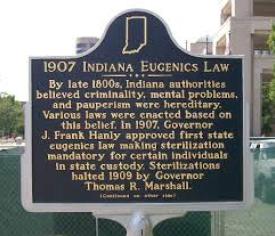 During a sad chapter in our history, modern eugenics argued for and actually practiced “Artificial Selection ” on our fellow humans by weeding out the “unfit”.
During a sad chapter in our history, modern eugenics argued for and actually practiced “Artificial Selection ” on our fellow humans by weeding out the “unfit”.
The state of Indiana passed a Eugenics inspired sterilization law in 1907. The law was struck down in 1921 by the Indiana Supreme Court after 2500 people had been involuntarily sterilized by the state. Sterilization of institutionalized patients continued to the mid-1970’s in 33 states. In all, about 60,000 Americans were involuntarily sterilized. The topic of Eugenics is still active, as this article on the Huff Post demonstrates.
Natural Selection – What is it ?
The idea here is that mother nature replaces the animal breeder. Animals having traits more adapted to their environment will survive and reproduce, continuing those traits in the offspring. Those animals having undesirable or less adapted traits would usually not survive and therefore not reproduce.
Dr Shapiro explains Natural Selection in his article (2):
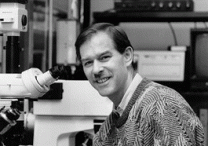 “Variants fittest (best able) to survive the Malthusian struggle for existence and reproduction in a world of limited resources would progressively become different and dominant. Eventually, differences would accumulate to the point that new species would form.”
“Variants fittest (best able) to survive the Malthusian struggle for existence and reproduction in a world of limited resources would progressively become different and dominant. Eventually, differences would accumulate to the point that new species would form.”
Dr Shapiro points out the Darwin’s artificial selection has never actually produced a new body plan or new species, so it is ironic that Darwin would use “Natural Selection” as a proposed mechanism for evolution of simple to more complex life forms. Shapiro points out that :
Darwin “ignored the inconvenient fact that human selection for altered traits has never generated a truly new organismal feature (e.g., a limb or an organ) or formed a new species. Selection only modifies existing characters.“
Evolution – Gradual or Sudden ?
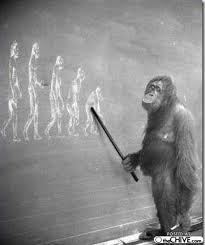 Another feature of Darwin’s Theory was that variation was “continual and small”. Change occurred in small steps. “Evolutionary innovation had to be gradual”
Another feature of Darwin’s Theory was that variation was “continual and small”. Change occurred in small steps. “Evolutionary innovation had to be gradual”
From Dr Shapiro:
“Darwin was correct in believing that natural selection could only play a creative role if variation was continual and small. Based on the “Uniformitarian” idea that change had to occur in the small steps we observe under normal conditions, he originally insisted that evolutionary innovation had to be gradual. “If it could be demonstrated that any complex organ existed, which could not possibly have been formed by numerous, successive, slight modifications, my theory would absolutely break down. But I can find out no such case”
Sudden Changes Outside of Natural Selection
Darwin acknowledged that sudden changes in evolution could occur independently of natural selection . He wrote
“… variations which seem to us in our ignorance to arise spontaneously. It appears that I formerly underrated the frequency and value of these latter forms of variation, as leading to permanent modifications of structure independently of natural selection“ (Origin of Species, 6th edition, Chapter XV, p. 395, emphasis added by Dr James A Shapiro).
Dr Shapiro points out that the modern science of cytogenetics and molecular genetics has provided insight into biological novelties arising “independently of natural selection — hybridization, genome duplication, symbiogenesis, chromosome restructuring, horizontal DNA transfer, mobile genetic elements, epigenetic switches, and natural genetic engineering (the ability of all cells to cut, splice, copy, and modify their DNA in non-random ways). ” (2)
“The genome sequence record tells us that these processes have accompanied rapid changes in all kinds of organisms. We know that many of them are activated by stress under extraordinary circumstances.”(2)
Natural Genetic Engineering (NGE) and Evolution
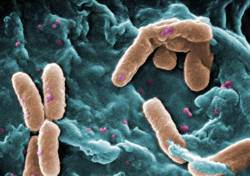 Natural Genetic Engineering is defined as the “ability of all cells to cut, splice, copy, and modify their DNA in non-random ways”. Dr. James A Shapiro goes on to explain NGE in this article on the Huffington post.(8)
Natural Genetic Engineering is defined as the “ability of all cells to cut, splice, copy, and modify their DNA in non-random ways”. Dr. James A Shapiro goes on to explain NGE in this article on the Huffington post.(8)
“NGE is shorthand to summarize all the biochemical mechanisms cells have to cut, splice, copy, polymerize and otherwise manipulate the structure of internal DNA molecules, transport DNA from one cell to another, or acquire DNA from the environment. Totally novel sequences can result from de novo untemplated polymerization or reverse transcription of processed RNA molecules.
 NGE describes a toolbox of cell processes capable of generating a virtually endless set of DNA sequence structures in a way that can be compared to erector sets, LEGOs, carpentry, architecture or computer programming.”(8)
NGE describes a toolbox of cell processes capable of generating a virtually endless set of DNA sequence structures in a way that can be compared to erector sets, LEGOs, carpentry, architecture or computer programming.”(8)
While we can now relegate Natural Selection and Random Mutation to the dustbin of history, declare NGE as the new mechanism for evolution, the details are yet to be uncovered.
“While NGE can help in understanding the molecular details of rapid and widespread genome change, it does not tell us what makes genomic novelties come out to be useful. How natural genetic engineering leads to major new inventions of adaptive use remains a central problem in evolution science.”(8)
Random Mutation and Evolution – Proofreading and Error Correction
 Another dogma of Neo-Darwinism is the idea of random mutation as a necessary component of the mechanism of evolution. Random mutation was thought to produce the variation and diversity in a gradual way.
Another dogma of Neo-Darwinism is the idea of random mutation as a necessary component of the mechanism of evolution. Random mutation was thought to produce the variation and diversity in a gradual way.
Science has shown that the genome has “proof reading and repair systems“. These are elaborate self correcting and self repairing mechanisms which correct random mutations. These repair mechanisms are also components of “natural genetic engineering” in the cell. If mutations are not repaired by cell machinery and persist, they are harmful, leading to genetic disease. These harmful mutations create “monsters”, not new adaptive traits, nor new species.(10)
From Dr Shapiro (10):
“Before we learned about biochemical systems for DNA reorganization, physical damage from radiation, radiation, chemical damage from alkylating agents and other reactive substances, spontaneous chemical changes, and inevitable errors in the fidelity of replication were thought to be the main agents of genetic change. It is very important to recognize that living cells resemble man-made systems for information processing and communication in their use of mechanisms for error detection and correction. These mechanisms minimize the degradation of information through accidents which are inevitable in all complex systems. Cells illustrate the application of this principle with multiple genomic proofreading and repair systems that anticipate a wide range of accidental genetic changes, including replication errors, chemical changes and radiation damage.”(10)
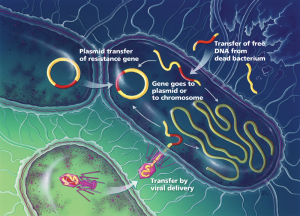 The Rapid Evolution of Antibiotic Resistant Bacteria
The Rapid Evolution of Antibiotic Resistant Bacteria
Left Image Caption: “Bacteria acquire resistance by exchanging conjugative plasmids (circular units of DNA), by acquiring DNA released from dead cells, and by transferring resistance genes packaged in viruses.”
The case of rapidly acquired antibiotic resistance in pathogenic bacteria is a highly studied example of evolution which again supports the theory of natural genetic engineering, not random mutations as the mechanism for evolutionary change. (10) Left Image courtesy of: Antibiotic_Resist_Carol_Potera_2013
This discussion by Dr James A Shapiro comes from his articles in the Huff Post: The Distinct Roles of Selection, Horizontal Transfer and Natural Genetic Engineering in Dangerous Superbug Evolution and this article by Dr Shapiro on Evolutionary Lessons From SuperBugs.
Above Image: Schematic Representation of Conjugation, a Plasmid (Blue Circle) transfers from one bacterial cell to another, courtesy of science prof online.
Enter the Plasmid, a Circular Strand of DNA
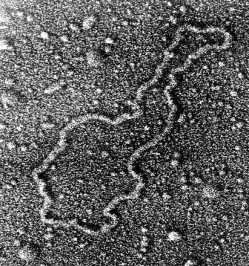 In a form of HGT, Horizontal Gene Transfer, Plasmids, little circular molecules of portable DNA, transmit the antibiotic resistant coding sequence to the new bacteria.
In a form of HGT, Horizontal Gene Transfer, Plasmids, little circular molecules of portable DNA, transmit the antibiotic resistant coding sequence to the new bacteria.
Left Image electron microscope image of Plasmid, cover courtesy of PNAS.
The plasmid’s job is to distribute the antibiotic resistant genes throughout an unselected population of bacteria. To make matters even worse, the plasmids may encode resistance to many different antibiotics, conferring “multiple antibiotic resistance” to the bacterial population. The antibiotic resistant bacteria “acquired new biochemical activities that could destroy or inactivate the antibiotics, chemically alter their targets, or remove them from the bacterial cell”.
“Faced with such a powerful bacterial toolbox for accumulating and spreading antibiotic resistance, it is no wonder that we have been caught off guard underestimating the capacity of these small cells to evolve high levels of resistance quickly.”
“Many questions remain to be clarified, such as where the resistance sequences themselves arose”.
Another Example of Non-Darwinian Evolution
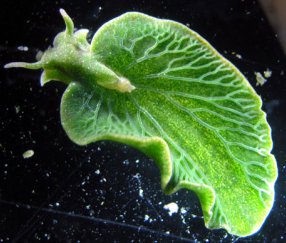 Thanks and credit goes to Scott Baker, managing editor of Op Ed News sending me this fascinating example of the sea slug that has acquired a novel function, photosynthesis by horizontal gene transfer from ingested algae. Image at left: Rich green color of the photosynthesizing sea slug, Elysia chlorotica by Patrick Krug courtesy of Science Daily.
Thanks and credit goes to Scott Baker, managing editor of Op Ed News sending me this fascinating example of the sea slug that has acquired a novel function, photosynthesis by horizontal gene transfer from ingested algae. Image at left: Rich green color of the photosynthesizing sea slug, Elysia chlorotica by Patrick Krug courtesy of Science Daily.
This is a beautiful example of non-Darwinian “rapid evolution” using HGT, one of the tools in the “Natural Genetic Engineering” toolbox. Author of the paper, Sidney K. Pierce says:
“When a successful transfer of genes between species occurs, evolution can basically happen from one generation to the next, he notes, rather than over an evolutionary timescale of thousands of years.”
Addendum: Lynn Margulis says thet random mutation is never enough for novelty in evolution. 2004 interview:
For part one of this series see: Part One.
Update: Part 1: What’s the matter with evolution?
Science | A ranking of the top five scientific problems found in evolutionary theory By Casey Luskin April 25, 2015,
Part 2: What’s the matter with evolution?
Science | Five more scientific problems found in evolutionary theory
Jeffrey Dach MD
7450 Griffin Road Suite 190
Davie, Fl 33314
954-792-4663
LINKS and References
1) Reply to Laurence A Morans review of Evolution A View From 21st Century James A Shapiro
My argument is that molecular research over the past sixty years on DNA change processes has taught us that virtually all genetic variation results from the action of regulated cell biochemistry, including a wide array of cutting, splicing and polymerizing functions that I summarize under the term “natural genetic engineering”. I assert that this realization represents a fundamental shift from the conventional view that genetic change is a random, accidental process.
2) http://www.huffingtonpost.com/james-a-shapiro/does-natural-selection-evolution_b_1769524.html
James A. Shapiro Does Natural Selection Really Explain What Makes Evolution Succeed?
Have we learned since 1859 about processes that can lead to organism change “independently of natural selection?” The answer is overwhelmingly positive.
Two fields principally illuminated the basic mechanisms of heredity and variation:
cytogenetics (the study of chromosome behavior in heredity using both genetic and microscopic methods) and molecular genetics (using DNA analysis to identify the nature of genome change).
In combination, cytogenetics and molecular genetics have taught us about many processes that lead to biological novelties “independently of natural selection” — hybridization, genome duplication, symbiogenesis, chromosome restructuring, horizontal DNA transfer, mobile genetic elements, epigenetic switches, and natural genetic engineering (the ability of all cells to cut, splice, copy, and modify their DNA in non-random ways). As previous blogs document and as future blogs will discuss, the genome sequence record tells us that these processes have accompanied rapid changes in all kinds of organisms. We know that many of them are activated by stress under extraordinary circumstances.
3) http://www.counterpunch.org/2012/05/07/the-evolution-paradigm-shift/
May 07, 2012 An Interview With James Shapiro The Evolution Paradigm Shift by SUZAN MAZUR
Dawkins and his ill-conceived atheist crusade hurts science education and hurts evolutionary science. Both Coyne and Dawkins have been characterized as having a neo-atheist agenda in attacking religion.
Both Coyne and Dawkins are doing well for themselves by being vitriolic and vehement in their campaign against religious belief and against some of the more foolish things that religious fundamentalists do. But I suspect ego gratification is the major driver more than financial gain. Obviously it’s nice if you make money at the same time.
back in the late 60s and 70s and since then we’ve learned about a wide variety of biochemical systems that cells use to restructure their genomes as an active process. Genome change is not the result of accidents. If you have accidents and they’re not fixed, the cells die. It’s in the course of fixing damage or responding to damage or responding to other inputs — in the case I studied, it was starvation — that cells turn on the systems they have for restructuring their genomes. So what we have is something different from accidents and mistakes as a source of genetic change. We have what I call “natural genetic engineering.” Cells are acting on their own genomes in a large variety of well- defined non-random ways to bring about change.
So if genetic change is not a series of accidents and not a series of necessarily small changes, then how does it work out in evolution?
That’s where the DNA record from genome sequencing comes in and confirms what many of us had argued for a long time: namely, all of these systems of genetic change, of natural genetic engineering, have played a major role in evolutionary change. We have a new view of how cells operate in evolution, which is much more information technology friendly.
4) http://www.huffingtonpost.com/james-a-shapiro/evolution-debate_b_1425133.html
James A. Shapiro What Is the Best Way to Deal With Supernaturalists in Science and Evolution?
The conventional approach has been to circle the wagons around mid-19th and mid-20th century ideas (Darwinism and neo-Darwinism). This approach has not been successful. One reason Darwinism has failed to convince skeptics may be that it ignores over 60 years of molecular science.
Thirty years ago, I was at a conference in Cambridge, England, to celebrate the centennial of Darwin’s death. There, Richard Dawkins began his lecture by saying, “I will not only explain that Darwin had the right answer, but I will show that he had the only possible right answer.”
Hearing this (and knowing that alternative explanations inevitably arise in science), I said to myself that the Creationists have a point. They are dealing with a form of religious belief on the “evolution” side. Dawkins’ transformation into an aggressive proselytizer for his undoubting and absolutist version of atheism confirms this conclusion.
One of the Creationists’ main tools is the argument that evolutionists are simply militant atheists in drag, who care more about dissing religion than about understanding evolution. Dawkins’ ill-considered crusade just bolsters their position.
Rather than accept that evolution science is always a tentative work in progress, conventional evolutionists make absolutist statements like “all the facts are on my side.” Making obviously inflated and unrealistic assertions is hardly likely to convince anyone who has serious questions.
5) http://www.huffingtonpost.com/james-a-shapiro/inconvenient-truths-why-a_b_2228277.html
James A. Shapiro Author, ‘Evolution: A View from the 21st Century’; Professor of Microbiology, University of Chicago
Inconvenient Truths: Why Are Self-Styled Defenders of Evolution so Resistant to Lessons From Molecular Genetics?
6) http://www.huffingtonpost.com/james-a-shapiro/natural-genetic-engineeri_b_1442309.html
James A. Shapiro Natural Genetic Engineering and Natural Selection: Perplexing Delusions of Certain Neo-Darwinist Advocates
7) pdf The_Read_Write_genome_Physics_of_life_James_A_Shapiro_2013
Shapiro, James A. “How life changes itself: The Read–Write (RW) genome.” Physics of life reviews 10.3 (2013): 287-323.
——————————————————-
8) http://www.huffingtonpost.com/james-a-shapiro/what-natural-genetic-engi_b_2783419.html
James A. Shapiro What Natural Genetic Engineering Does and Does Not Mean
For me, NGE is shorthand to summarize all the biochemical mechanisms cells have to cut, splice, copy, polymerize and otherwise manipulate the structure of internal DNA molecules, transport DNA from one cell to another, or acquire DNA from the environment. Totally novel sequences can result from de novo untemplated polymerization or reverse transcription of processed RNA molecules. NGE describes a toolbox of cell processes capable of generating a virtually endless set of DNA sequence structures in a way that can be compared to erector sets, LEGOs, carpentry, architecture or computer programming.
NGE operations are not random. Each biochemical process has a set of predictable outcomes and may produce characteristic DNA sequence structures. The cases with precisely determined outcomes are rare and utilized for recurring operations, such as generating proper DNA copies for distribution to daughter cells.
It is essential to keep in mind that “non-random” does not mean “strictly deterministic.” We clearly see this distinction in the highly targeted NGE processes that generate virtually endless antibody diversity.
In summary, NGE encompasses a set of empirically demonstrated cell functions for generating novel DNA structures. These functions operate repeatedly during normal organism life cycles and also in generating evolutionary novelties, as abundantly documented in the genome sequence
Some NGE functions help us to understand the mechanistic details of rapid evolutionary changes. Rapid changes include the evolution of novel proteins by reorganization of existing functional domains to generate new combinations of biochemical activities and the distribution of regulatory signals to multiple sites in the genome.
@@@@@@@@@@@@@@@@@@@@@@@@@@@@@@
While NGE can help in understanding the molecular details of rapid and widespread genome change, it does not tell us what makes genomic novelties come out to be useful. How natural genetic engineering leads to major new inventions of adaptive use remains a central problem in evolution science. To address this problem experimentally, we need to do more ambitious laboratory evolution research looking for complex coordinated changes in the genome.
___________________
9) http://www.huffingtonpost.com/james-a-shapiro/does-natural-selection-evolution_b_1769524.html
James A. Shapiro Does Natural Selection Really Explain What Makes Evolution Succeed?
Unlike most followers, Darwin acknowledged later that significant, sudden changes could occur in a fundamentally different way. He wrote about “… variations which seem to us in our ignorance to arise spontaneously. It appears that I formerly underrated the frequency and value of these latter forms of variation, as leading to permanent modifications of structure independently of natural selection” (Origin of Species, 6th edition, Chapter XV, p. 395, emphasis added).
So a way to rephrase my question is to ask: Have we learned since 1859 about processes that can lead to organism change “independently of natural selection?” The answer is overwhelmingly positive.
Two fields principally illuminated the basic mechanisms of heredity and variation:
cytogenetics (the study of chromosome behavior in heredity using both genetic and microscopic methods) and
molecular genetics (using DNA analysis to identify the nature of genome change).
In combination, cytogenetics and molecular genetics have taught us about many processes that lead to biological novelties “independently of natural selection” — hybridization, genome duplication, symbiogenesis, chromosome restructuring, horizontal DNA transfer, mobile genetic elements, epigenetic switches, and natural genetic engineering (the ability of all cells to cut, splice, copy, and modify their DNA in non-random ways). As previous blogs document and as future blogs will discuss, the genome sequence record tells us that these processes have accompanied rapid changes in all kinds of organisms. We know that many of them are activated by stress under extraordinary circumstances.
Fortunately for evolution science and science education, 20th century studies of inheritance at the cellular and molecular level have freed us from the intellectual straightjacket of gradual random change and natural selection. In the 21st century, we can think open-mindedly about the cellular and molecular processes that lead to biological diversity. Today, we can investigate how they work to achieve evolutionary success, particularly in crisis situations, when novelty is most necessary.
10) pdf
Natural_genetic_engineering_evolution_James_A_Shapiro_Transposable Elements_1993
Shapiro, James A. “Natural genetic engineering in evolution.” Transposable Elements and Evolution. Springer Netherlands, 1993. 325-347.
The objective of this paper is to discuss certain kinds of molecular genetic data which, in the author’s opinion, raise serious questions about the prevailing evolutionary wisdom based on notions of piecemeal, stochastic genetic change due to replication errors and physico-chemical instabilities.
1) evolutionary novelty often does not reside in the invention of new biochemical processes by the continual modification and selection of individual proteins. Instead, evolution appears to proceed by the utilization of basic biochemical routines in different combinations indifferent organisms.
With few exceptions, the structural proteins of all mammals, for example, are probably interchangeable; what makes a mouse different from an elephant is when and how those molecules are synthesized and assembled during development.
2) Mosaic structure of genome.
Protein coding regions.
Transcriptional regulatory regions.
Repetitive sequence elements.
repetitive sequences show a high degree of taxonomic specificity (Dover, 1982). For example, a very good primate taxonomy can be
constructed on the basis of restriction site polymorphisms in alphoid DNA (Donehower & Gillespie, 1979), and various groups of mammals are identifiable by their characteristic dispersed retroposons (Rogers, 1985; Weiner et al., 1986). Indeed, the
abundance and distribution of repetitive elements are often among the best available genomic characters for species identification. This is true both of prokaryotes and eukaryotes.
taxonomically-specific repetitive DNA sequences help define the ‘system architecture’ of each species, perhaps serving a role in hierarchical organization of different genomic regions.
In other words, it can be argued that much of genome change in evolution results from a genetic engineering process utilizing the biochemical systems for mobilizing and reorganizing DNA structures present in living cells.
#############################################
One major tenet of conventional evolutionary theory is that genetic changes arise sporadically without reference to the needs
of the organism. As we shall see, the molecular genetic data suggest a different point of view. Examples are accumulating of systems where DNA rearrangements occur in a predictable, biologically significant manner. Moreover, there are several
systems where coordinated genome-wide rearrangements
are integrated into developmental cycles. Thus, one of the fundamental genetic facts underlying any modern evolutionary theory will have to be cellular capacity for specific and widespread genomic change.
One generalization which can be based on the study of genetic variation is that there exist a wide array of elaborate biochemical systems for replicating, correcting, repairing, packaging, rearranging and transporting DNA molecules. In other words, living cells have many mechanisms at their disposal for processing DNA according to their needs.
Retooling for a new model: the capacity for genome-wide changes
One of the major issues in evolutionary theory is the question of the relative importance of accumulated micromutations versus systemic macromutations. The conventional wisdom is that mutational
events are sporadic, undirected and independent, and a tacit assumption is generally made that each new mutation arises in a single individual or single gamete. Nonetheless, a closer consideration of the P-M system of hybrid dysgenesis in Drosophila
and of macronuclear development in ciliates will show that multiple mutations can occur in clusters of gametes and that thousands of coordinated genome-wide changes can occur in a single cell
generation.
An evolutionary case history: bacterial resistance to antibiotic chemotherapy
Since World War II, a major evolutionary event has taken place – the emergence of multiply drug resistant bacteria in response to widespread antibiotic use for chemotherapy and prophylaxis. Since the molecular details of this process have been extensively
characterized, we have a unique opportunity to examine how well the facts fit with different theoretical perspectives.
Resistance determinants did not arise (as predicted) by gradual modifications of pre-existing cellular machinery but appeared as
complete systems that could spread rapidly between distinct clones and species.
Work on the physiology of resistance has revealed a variety of sophisticated biochemical mechanisms for dealing with antibiotics (Foster,1983):
• inactivation by hydrolysis, acetylation, adenylylation,
and phosphorylation;
• removal from the cytoplasm by efflux pumps
and volatilization;
• covalent modification of target molecules to render them drug-insensitive without altering their
activities;
• substitution of drug-insensitive enzymes for
their normal (sensitive) analogues.
How these different resistance determinants originally arose is itself an intriguing evolutionary question.
For the present discussion, however, what is important is the observation that evolving bacterial cells incorporated DNA sequences encoding novel biochemical systems; they did not use the slower and less efficient process of accumulating mutations
altering basic cellular functions.
Quality control: preventing accidental genetic change by proofreading and repair systems Before we learned about biochemical systems for DNA reorganization, physical damage from radiation, radiation, chemical damage from alkylating agents and other reactive substances, spontaneous chemical changes, and inevitable errors in the fidelity of replication were thought to be the main agents of genetic change. It is very important to recognize that living cells resemble man-made systems for information processing and communication in their use of mechanisms for error detection and correction. These mechanisms minimize the degradation of information through accidents which are inevitable in all complex systems. Cells illustrate the application of this principle with multiple genomic proofreading and repair systems that anticipate a wide range of accidental genetic changes, including replication errors, chemical changes and radiation damage.
Mobile_DNA_evolution_21st_century_James_A_Shapiro_2010
Shapiro, James A. “Mobile DNA and evolution in the 21st century.” Mobile DNA 1.4 (2010): 1-14.
Scientific history has had a profound effect on the theories of evolution. At the beginning of the 21st century, molecular cell biology has revealed a dense structure of information-processing networks that use the genome as an interactive read-write (RW) memory system rather than an organism blueprint. Genome sequencing has documented the importance of mobile DNA activities and major genome restructuring events at key junctures in evolution:
exon shuffling, changes in cis-regulatory sites, horizontal transfer, cell fusions and whole genome doublings (WGDs).
The natural genetic engineering functions that mediate genome restructuring are activated by multiple stimuli, in particular by events similar to those found in the DNA record: microbial infection and interspecific hybridization leading to the formation of allotetraploids. These molecular genetic discoveries, plus a consideration of how
mobile DNA rearrangements increase the efficiency of generating functional genomic novelties, make it possible to formulate a 21st century view of interactive evolutionary processes. This view integrates contemporary knowledge of the molecular basis of genetic change, major genome events in evolution, and stimuli that activate DNA restructuring with classical cytogenetic understanding about the role of hybridization in species diversification.
Physiology_RW_Genome_James _A_Shapiro_2014
The Journal of Physiology Vol 592, Issue 11, pages 2319–2341, 1 June 2014. Physiology of the read–write genome James A. Shapiro
Discoveries in cytogenetics, molecular biology, and genomics have revealed that genome change is an active cell-mediated physiological process. This is distinctly at variance with the pre-DNA assumption that genetic changes arise accidentally and sporadically. The discovery that DNA changes arise as the result of regulated cell biochemistry means that the genome is best modelled as a read–write (RW) data storage system rather than a read-only memory (ROM). The evidence behind this change in thinking and a consideration of some of its implications are the subjects of this article. Specific points include the following: cells protect themselves from accidental genome change with proofreading and DNA damage repair systems; localized point mutations result from the action of specialized trans-lesion mutator DNA polymerases; cells can join broken chromosomes and generate genome rearrangements by non-homologous end-joining (NHEJ) processes in specialized subnuclear repair centres; cells have a broad variety of natural genetic engineering (NGE) functions for transporting, diversifying and reorganizing DNA sequences in ways that generate many classes of genomic novelties; natural genetic engineering functions are regulated and subject to activation by a range of challenging life history events; cells can target the action of natural genetic engineering functions to particular genome locations by a range of well-established molecular interactions, including protein binding with regulatory factors and linkage to transcription; and genome changes in cancer can usefully be considered as consequences of the loss of homeostatic control over natural genetic engineering functions.
http://voicesfromoxford.com/video/how-life-changes-itself/412
The Read-Write (RW) Genome
Lecturer: James Shapiro Institution: University of Chicago, USA
Talk: The Read-Write (RW) genome
Symposia: Physiology and Evolution: Has physiology become relevant again to evolutionary biology This talk was given at the International Union of Physiological Sciences (IUPS) held in Birmingham, UK in July 2013.
Revisiting the central dogma in 21st century James A Shapiro 2009
Shapiro, James A. “Revisiting the central dogma in the 21st century.” Annals of the New York Academy of Sciences 1178.1 (2009): 6-28.
Bacteria are small but not stupid Cognition 2006 James A Shapiro Shapiro, James A. “Bacteria are small but not stupid: Cognition, natural genetic engineering, and sociobacteriology.” 2006
Thinking about evolution cellular computing Natural Computing James A Shapiro 2005 Natl Computing
__________________________________________________
http://www.ncbi.nlm.nih.gov/pubmed/23406696
Phys Biol. 2013 Apr;10(2):026001.
Stress-induced hypermutation as a physical property of life, a force of natural selection and its role in four thought experiments.
Hilbert L1.
The independence of genetic mutation rate from selection is central to neo-Darwinian evolutionary theory. However, it has been continuously challenged for more than 30 years by experimental evidence of genetic mutation rate transiently increasing in response to stress (stress- induced hypermutation, SIH). The prominent concept of evolved evolvability (EE) explains that natural selection for strategies more competitive at evolutionary adaptation itself gives rise to mechanisms dynamically adjusting mutation rates to environmental stress. Here, we theoretically investigate the alternative (not mutually exclusive) hypothesis that SIH is an inherent physical property of all genetically reproducing life. We define stress as any condition lowering the capability of utilizing metabolic resources for genome storage and replication. This thermodynamical analysis indicates stress-induced increases in the genetic mutation rate in genome storage and in genome replication as inherent physical properties of genetically reproducing life. Further integrating SIH into an overall organismic thermodynamic budget identifies SIH as a force of natural selection, alongside death rate, replication rate and constitutive mutation rate differences. We execute four thought experiments with a non-recombinant lesion mutant strain to predict experimental observations due to SIH in response to different stresses and stress combinations. We find (1) acceleration of adaptation over models without SIH, (2) possibility of adaptation at high stresses which are not explicable by mutation in genome replication alone and (3) different adaptive potential under high growth-inhibiting versus high lethal stresses. The predictions are directly comparable to culture experiments (colony size time courses, antibacterial resistance assay and occurrence of lesion-reversion mutant colonies) and genome sequence analysis. Considering suggestions of drug-mediated disruption of SIH and attempts to target mutation-associated sites with chemotherapeutic agents to prevent resistance, our findings seem to be relevant knowledge for resistance-averse drug development and administration.
——-
Mae-Wan Ho
Dr Mae Wan Ho Cut and splice vs random accidents
http://www.i-sis.org.uk/paris.php?printing=yes
The End of Bad Science and Beginning Again with Life
Mae-Wan Ho Institute of Science in Society and Department of Biological Sciences, Open University, Walton Hall, Milton Keynes, MK7 6AA, UK
This is a public Lecture for Conference on “The Limit of Natural Selection”, French Senate, Paris, March 18, 2000
Recently, molecular geneticist James Shapiro has joined the debate. He is critical of neo-Darwinians like Richard Dawkins and John Maynard Smith who are still clinging to the discredited paradigm. “Localized random mutation, selection operating “one gene at a time” (John Maynard Smith’s formulation), and gradual modification of individual functions are unable to provide satisfactory explanation for the molecular data, no matter how much time for change is assumed. There are simply too many potential degrees of freedom for random variability and too many interconnections to account for.”11
And yet, the variations are far from random. The processes responsible for the fluidity of the genome form a highly sophisticated regulatory system, which can provide hyper-variability or stability for genes or genomes as required. All organisms, from bacteria to human beings, possess a wide range of repair and proof-reading functions to remove accidental changes to DNA sequences and correct errors resulting from physiological and physical insults. The same cells also possess numerous biochemical mechanisms for changing and reorganizing DNA through ‘natural genetic engineering’ – processes that include cutting and splicing of DNA molecules into new sequence arrangements (like the immunoglobulin genes). Most frequently, natural genetic engineering involves mobile genetic elements, found in all genomes, which can move from one position to another, enabling organisms to respond to environmental challenges.
The ability to activate those mechanisms under stress can significantly accelerate evolutionary change in times of crisis without threatening genetic stability under ordinary circumstances. Shapiro12 suggests that further studies of transposable elements and DNA rearrangements may throw light on directed mutations. Just as signal-transduction systems of the cell can direct the transcriptional apparatus to specific genes, so there might be mutational apparatus(es) that can be similarly directed to mutate specific genes. In other words, the natural genetic engineering done by organisms themselves is quite precise, even though we don’t yet know how they manage it.
http://www.i-sis.org.uk/Evolution_by_Natural_Genetic_Engineering.php
New Genetics and Evolution
Evolution by Natural Genetic Engineering
New findings in genetics show that evolution happens by precisely targeted natural genetic engineering and not by the natural selection of random mutations, says leading molecular biologist James Shapiro, but what are the implications for the safety of GMOs and social policies?
NDM-1-gene-superbug Wear, U. K. “Emergence of a new antibiotic resistance mechanism in India, Pakistan, and the UK: a molecular, biological, and epidemiological study.” (2010).
Yoon, Young Geol, Michael D Koob, and Young Hyun Yoo.
“Re-Engineering the Mitochondrial Genomes in Mammalian Cells.” Anatomy & Cell Biology 43.2 (2010): 97–109. PMC. Web. 6 Feb. 2015.
Horizontally_Transferred_Algal_Gene_Sea_Slug_Sidney_Pierce_Biol_Bull_2014
Julie A. Schwartz, Nicholas E. Curtis, and Sidney K. Pierce. FISH Labeling Reveals a Horizontally Transferred Algal (Vaucheria litorea) Nuclear Gene on a Sea Slug (Elysia chlorotica) Chromosome. Biol Bull, 2014 227:300-312
Fantastically Wrong: What Darwin Really Screwed Up About Evolution BY MATT SIMON
Link to this article:http://wp.me/p3gFbV-2A2
Jeffrey Dach MD
7450 Griffin Road, Suite 190
Davie, Fl 33314
954-792-4663
http://www.jeffreydachmd.com
http://www.drdach.com
http://www.naturalmedicine101.com
http://www.bioidenticalhormones101.com
Serving Areas of: Hollywood, Aventura, Miami, Fort Lauderdale, Pembroke Pines, Miramar, Davie, Coral Springs, Cooper City, Sunshine Ranches, Hallandale, Surfside, Miami Beach, Sunny Isles, Normandy Isles, Coral Gables, Hialeah, Golden Beach ,Kendall,sunrise, coral springs, parkland,pompano, boca raton, palm beach, weston, dania beach, tamarac, oakland park, boynton beach, delray,lake worth,wellington,plantation
The post James A Shapiro Natural Genetic Engineering and Evolution Part Two appeared first on Jeffrey Dach MD .






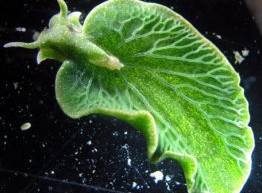
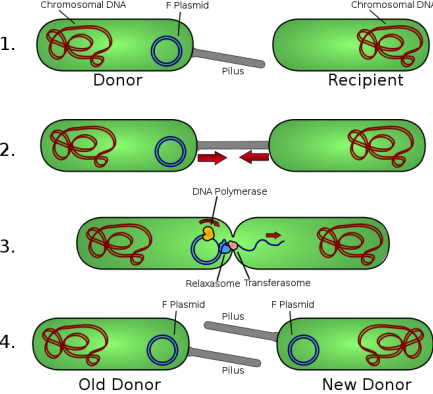



Leave a Comment
You must be logged in to post a comment.